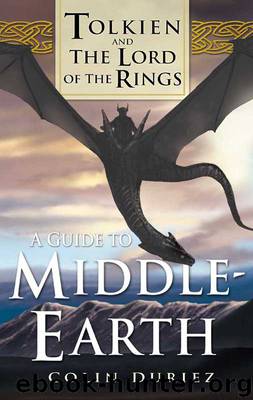A Guide to Middle Earth by Colin Duriez

Author:Colin Duriez
Format: epub
Publisher: History Press (Perseus)
Published: 2013-07-30T16:00:00+00:00
Further reading
Clyde S. Kilby, Tolkien and The Silmarillion (1976).
Paul H. Kocher, A Reader’s Guide to The Silmarillion (1980).
Consolation Tolkien believed that consolation was a central quality of good fantasy or fairy tale – the kind of story he wrote in The Lord of the Rings‡ or the tale of Beren* and Lúthien,* the elf-maiden’. The quality is related to that of escape† (but not escapism). There are things ‘grim and terrible to fly from’, says Tolkien. ‘These are hunger, thirst, poverty, pain, sorrow, injustice, death.’ But even when people are fortunate enough not to face such extremes ‘there are ancient limitations from which fairy stories offer a sort of escape, and old ambitions and desires (touching the very root of fantasy) to which they offer a kind of satisfaction and consolation’. Some include the desire ‘to visit, free as a fish, the deep sea’ or to fly among the clouds. There are also primordial desires to survey the depths of space and time (see Sub-creation†) and to converse with animals.
The desire for talking animals comes from a sense of separation from nature,† from the fall.† C.S. Lewis tried to define such a desire like this:
We do not want merely to see beauty…. We want something else which can hardly be put into words – to be united with the beauty we see, to pass into it, to receive it into ourselves, to bathe in it, to become part of it. That is why we have peopled air and earth and water with gods and goddesses and nymphs and elves.
The oldest desire of course, Tolkien points out, is to escape death.† This desire is a common characteristic of the fairy stories of human beings. Elves would be concerned to escape deathlessness.
Tolkien feels however that the consolation of fairy-stories has a more important aspect than ‘the imaginative satisfaction of ancient desires’. This is the consolation of the Happy Ending. He coins the term, eucatastrophe, for this ending. Just as tragedy† is the true form of drama, its highest function, eucatastrophe is the true form of the fairy-tale.
Such eucatastrophe, the sudden ‘turn’ in the story, ‘is not essentially “escapist” or “fugative”. In its fairy tale – or otherworld – setting, it is a sudden and miraculous grace: never to be counted on to return.’ This is not to deny or make light of sorrow and failure, for their possibility ‘is necessary to the joy of deliverance’. What is denied, says Tolkien, is ‘universal final defeat’. This denial is ‘evangelium, giving a fleeting glimpse of Joy, Joy beyond the walls of the world, poignant as grief.’ This joy† ‘rends indeed the very web of story, and lets a gleam come though’.
The source of joy and consolation is objective (as it was for Tolkien’s friend C.S. Lewis). Reality itself is the grounding of the meaning of such stories. In his essay on fairy stories, Tolkien explicitly links consolation with the Christian gospel (see Christianity, Tolkien and†).
See also Fairy stories;† Apocalyptic, Tolkien and.†
Cosmology See Sub-creation;† God;† Christianity, Tolkien and;† Middle-earth;* ‘Ainunlindalë’.
Download
This site does not store any files on its server. We only index and link to content provided by other sites. Please contact the content providers to delete copyright contents if any and email us, we'll remove relevant links or contents immediately.
Sita - Warrior of Mithila (Book 2 of the Ram Chandra Series) by Amish(54510)
The Crystal Crypt by Dick Philip K(36596)
Cat's cradle by Kurt Vonnegut(15086)
Always and Forever, Lara Jean by Jenny Han(14705)
Ready Player One by Cline Ernest(14408)
The Last by Hanna Jameson(10091)
Year One by Nora Roberts(9611)
Persepolis Rising by James S. A. Corey(9126)
The remains of the day by Kazuo Ishiguro(8730)
Never let me go by Kazuo Ishiguro(8510)
Red Rising by Pierce Brown(8509)
Dark Space: The Second Trilogy (Books 4-6) (Dark Space Trilogies Book 2) by Jasper T. Scott(8045)
The handmaid's tale by Margaret Atwood(7634)
The Circle by Dave Eggers(6984)
Frank Herbert's Dune Saga Collection: Books 1 - 6 by Frank Herbert(6847)
The Testaments by Margaret Atwood(6652)
Legacy by Ellery Kane(6512)
Pandemic (The Extinction Files Book 1) by A.G. Riddle(6398)
Six Wakes by Mur Lafferty(6053)
